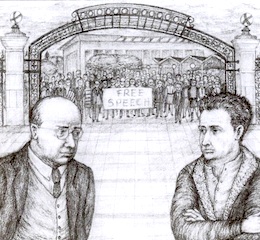|
J. William T. "Bill" Youngs, American Realities, Volume Two:
Historical Episodes from Reconstruction to the Present, Chapter Thirteen |
"Free Speech Protest" courtesy of the Wikipedia Commons
|
13. Turmoil on the Campuses
|
SummaryArguably the most tumultuous time in the history of American higher education began with the free speech movement at Berkeley in 1964. The free speech movement merged with a cultural revolution and an antiwar movement that ultimately spread across the United States.
|
Author reads from the Text
During the sixties the student movement at Berkeley became increasingly an expression of counterculture values. Jack Weinberg, who had spent thirty-two hours in the back seat of the police cruiser in Sproul Hall Plaza, coined a popular slogan for the movement: “Don’t trust anyone over thirty.” Counterculture leaders Abbie Hoffman and Jerry Rubin appeared often in Berkeley. The student leaders who demanded and won the right to free speech on campus went to the microphones again and again, challenging American values and campus rules. The first major issue following the FSM fall was an abortive “filthy speech movement” in early 1965, where students tested their freedom by featuring four-letter words in their speeches and on placards in Sproul Hall Plaza. That movement died of its own silliness: most students who cared about the speech issue thought it was being trivialized. But many other issues won broad support.

